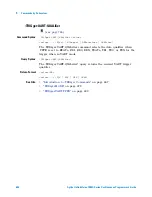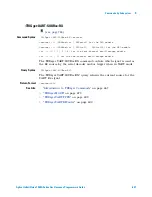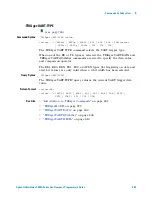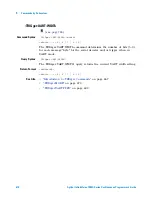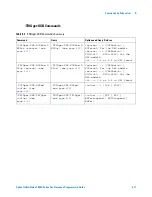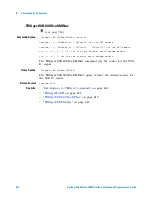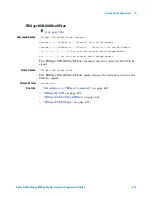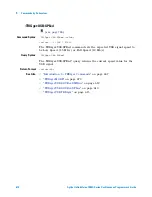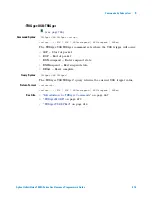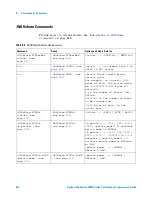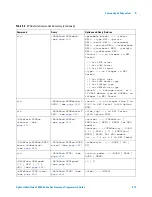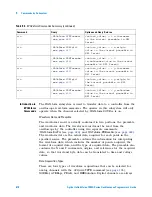
620
Agilent InfiniiVision 7000A Series Oscilloscopes Programmer's Guide
5
Commands by Subsystem
screen and the last value corresponds to the next- to- last time bucket on
the right side of the screen. Time buckets without data return 0. The time
values for each data point correspond to the position of the data point in
the data array. These time values are not transmitted.
AVERage Data
AVERage data consists of the average of the first n hits in a time bucket,
where n is the value returned by the :ACQuire:COUNt query (see
). Time buckets that have fewer than n hits return the average of
the data they do have. If a time bucket does not have any data in it, it
returns 0.
This data is transmitted over the interface linearly, starting with time
bucket 0 and proceeding through time bucket n- 1, where n is the number
returned by the :WAVeform:POINts? query (see
). The first value
corresponds to a point at the left side of the screen and the last value
corresponds to one point away from the right side of the screen. The
maximum number of points that can be returned in average mode is 1000
unless ACQuire:COUNt has been set to 1.
PEAK Data
Peak detect display mode is used to detect glitches for time base settings
of 500 us/div and slower. In this mode, the oscilloscope can sample more
data than it can store and display. So, when peak detect is turned on, the
oscilloscope scans through the extra data, picks up the minimum and
maximum for each time bucket, then stores the data in an array. Each
time bucket contains two data sample.
The array is transmitted over the interface bus linearly, starting with time
bucket 0 proceeding through time bucket n- 1, where n is the number
returned by the :WAVeform:POINts? query (see
). In each time
bucket, two values are transmitted, first the minimum, followed by the
maximum. The first pair of values corresponds to the time bucket at the
leftmost side of the screen. The last pair of values corresponds to the time
bucket at the far right side of the screen. In :ACQuire:TYPE PEAK mode
(see
), the value returned by the :WAVeform:XINCrement query
(see
) should be doubled to find the time difference between the
min- max pairs.
HRESolution Data
The high resolution (
smoothing
) mode is used to reduce noise at slower
sweep speeds where the digitizer samples faster than needed to fill
memory for the displayed time range.
Data Conversion
Содержание InfiniiVision 7000A Series
Страница 1: ...Agilent InfiniiVision 7000A Series Oscilloscopes Programmer s Guide...
Страница 34: ...34 Agilent InfiniiVision 7000A Series Oscilloscopes Programmer s Guide 1 What s New...
Страница 44: ...44 Agilent InfiniiVision 7000A Series Oscilloscopes Programmer s Guide 2 Setting Up...
Страница 58: ...58 Agilent InfiniiVision 7000A Series Oscilloscopes Programmer s Guide 3 Getting Started...
Страница 652: ...652 Agilent InfiniiVision 7000A Series Oscilloscopes Programmer s Guide 5 Commands by Subsystem...
Страница 750: ...750 Agilent InfiniiVision 7000A Series Oscilloscopes Programmer s Guide 8 Error Messages...
Страница 784: ...784 Agilent InfiniiVision 7000A Series Oscilloscopes Programmer s Guide 10 Synchronizing Acquisitions...
Страница 810: ...810 Agilent InfiniiVision 7000A Series Oscilloscopes Programmer s Guide 11 More About Oscilloscope Commands...
Страница 922: ...922 Agilent InfiniiVision 7000A Series Oscilloscopes Programmer s Guide Index...

